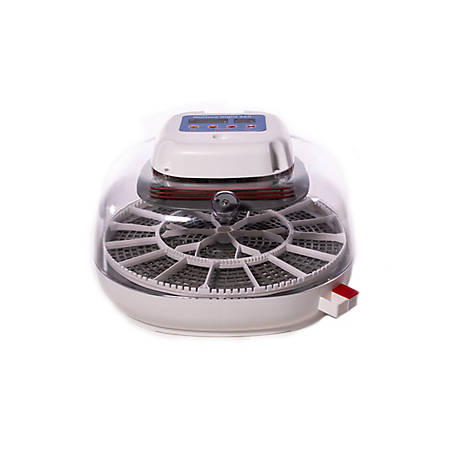I will be posting information on our efforts at the community center to transition to a barter and self-sustainable economy over the next few months. This post will center on our first effort to hatch chicks from our flock of seven Buff Orpington hens and one rooster (Sarge). We do not name the hens but my someone who will remain unnamed, calls them Nugget1 through Nugget7.
We are happy with this breed for their prolific egg laying, large size for meat, ability to withstand cold and good temperament. If you are considering raising chickens in the future, make a list of your expectations/requirements before selecting a breed including brooding.
Incubator

The Harris Farms 1030121 Nurture Right 360 Incubator is the perfect, easy-to-use incubator whether it is your first incubation or your hundredth incubation. The first-in-class features of this Nurture Right incubator make your at-home hatching a pleasant experience and supports high hatch rates. At Manna Pro, we believe in nurturing life and this incubator will help you do just that.
- Auto-stop: Nurture Right 360 incubator will stop turning eggs 3 days before hatch day
- Automatic egg turner: Eases the incubation process and helps stimulate hen hatch for higher hatch rate
- 360 visibility: Clear top on incubator makes it great for educational observation
- 360 induced airflow: Nurture Right 360 incubator provides optimal air circulation & temperature stability
- 22 egg capacity: Easy-to-use incubator can hold up to 22 chicken eggs, 12-18 duck eggs and 22-24 pheasant eggs
We collected 21 eggs over a three day period and kept them in a bowl at room temperature. The eggs were rotated periodically but no additional measures were taken.
On day 13 in the incubator, we candled the eggs and all but one had an air sac. We were able to see some movement and veins. The non-viable egg was discarded. On day 18 in the incubator, we checked to ensure that the automatic egg turner was off and removed the egg turning tray from the incubator. We also increased the humidity as outlined to 70%. We did monitor the humidity fairly closely throughout this process but it did drop overnight in some cases without any negative end results.
On day 20 (not 21) the chicks hatched. The above picture of 16 chicks was at the end of the day. The following morning, the remaining 3 chickens were transferred to a holding bin. The remaining egg had been viable and the chicken had almost broken out of the shell. I carefully removed the shell and the chick had died trying to hatch.
I will not address the difference of opinion concerning whether or not to help a chick hatch. In this case, the chick died in the night so the decision was not mine to make. For a first attempt, 19 chicks out of 21 eggs was a success in our minds.
Obviously the bin, pine shavings, chick feed, water dispenser and heat lamp were already in place from our previously store bought chicks last year. Our grandsons were able to see the chicks being born and they will never forget the memory.
So what to do with 19 chicks? The experience and knowledge gained was the primary goal. The secondary goals were to foster good will and find them good homes. The next afternoon, six were given to good friends down the road and five went to another friend. All have previous experience with chickens. We kept eight and are hoping for at least four hens.
In the future, I would like to learn how to sex the chickens. Feeding chicks for a few weeks and then having to cull roosters may not be practical if supplies are tight and/or feed is not available.
David DeGerolamo




So glad you’re doing this! I was going to stay off phone, but decided to take a break from researching chicken coop builds. Opened phone and here it is, all I was just trying to learn about 👍👍
My wife will enjoy this read also I am sure. Thanks for tips!
Nice! We have been raising chickens now for about 10 years… absolutely would not be without them. We currently have 25 hens and 5 roosters, and are getting easily 15-20 eggs a day right now. (BTW, I just fed them a huge pile of grass clippings, and they loved it). We let them out every morning and, except for their annoying habit of crapping on the deck right in front of the door, cannot imagine life without them. The eggs are about 100 times better than store eggs too.
We have an incubator, and have used it, as well as having a broody hen raise a batch (clutch?). Both methods work well, and am glad you are doing this. When the power goes out for the last time, you will be able to continue to eat.
We just got our bean poles up, and have a few more planting beds to complete, but all in all going pretty well. Got 50 asparagus roots planted last week, and have a zucchini starts that are already blooming and screaming to get in the ground. Have enjoyed fresh tomatoes and salads all winter long in the [;partially] below-grade greenhouse, and now getting the hydroponics reseeded with arugula (lettuce does not like warm temps).
And yes, we have named our roosters.
We also have done the incubator process, have even had a few hatch out naturally in the hen house. Last one was a rooster “Of course.”
And yes i have some rooster stories over the last few years. chuckle.
As other have stated, incubation is nice as long as the grid is up. A good hen, I have found the Cochin breed works great, will sit, hatch, and raise any chicks for you.
Great start and good idea, heairloom sed stock would be a good addition too.
I have limited solar now but our water electrical generation capacity has increased 5x in the past year. It should be enough for LED lights and miscellaneous applications.
Are you talking hydroelectric? We’ve been thinking about this… especially in the winter and spring when we have so much water flow in our creek. Would love to know what system you selected.
I am developing this system now. I will detail the steps we’ve taken last year to develop a springhead. Then the dam, springbox and water containment.
So, it is year 17 of the 17-year cicada cycle here in the south, so the forest should be getting very, very noisy soon. Last time I compared the sound to the USS Enterprise phasering the forest from orbit. I am wondering if the chickens will eat the cicadas, and at what point they’ll get tired of them. At least we won’t have to feed them for a couple weeks (hopefully).
Thank you for presenting this article. I have been thinking of chickens lately. This article moved me off dead center. Thanks again.
buffs are a dual purpose breed. raise those roosters for the freezer.
or sell them.
We also are hatching our eggs from our chickens. My husband was a life-long chicken fancier who knew them so well he could tell you what they were thinking! Bet you didn’t know chickens and all birds think. One issue about introducing hatchlings into a mature flock is that older chickens don’t take kindly to foreigners. You need enough hatchlings that you can introduce at one time so the older ones don’t attack the babes. The trick my husband used was to let one or two hens hatch out eggs. Then when the new chicks were a day or so old, he would introduce the incubated chicks by placing them in the nest at night. My brother and I are raising these and we come from a long line of farmers. The chicks are really a pleasure. In the past, at Easter, all the businesses and churches would give out chicks to the children. After a few weeks the fuzzy chicks would become obnoxious roosters and the children were done with them. My dad would bring them home to me. Invariably the Easter chicks would have problems such as their vents being plugged by sticky poop. I learned to carefully work the poop off with Vaseline. Now I prevent that by watching the chicks and catching them early. I use scissors to give them a “channel cut” like you do for cats, especially Persians. The other thing that causes the sticky poop is feed. It’s worth experimenting with different brands too find one the chicks can easily process and is not sticky.
We have also found that wire dog kennels, with hard wire on the outside, and an XI pee pad + heat lamp, make really good transitional pens for the chicks. Even though I have raise many chicks in livestock tanks with a wire top, the kennels seem to provide more air and are much easier to keep clean.
May everyone have a blessed Easter.